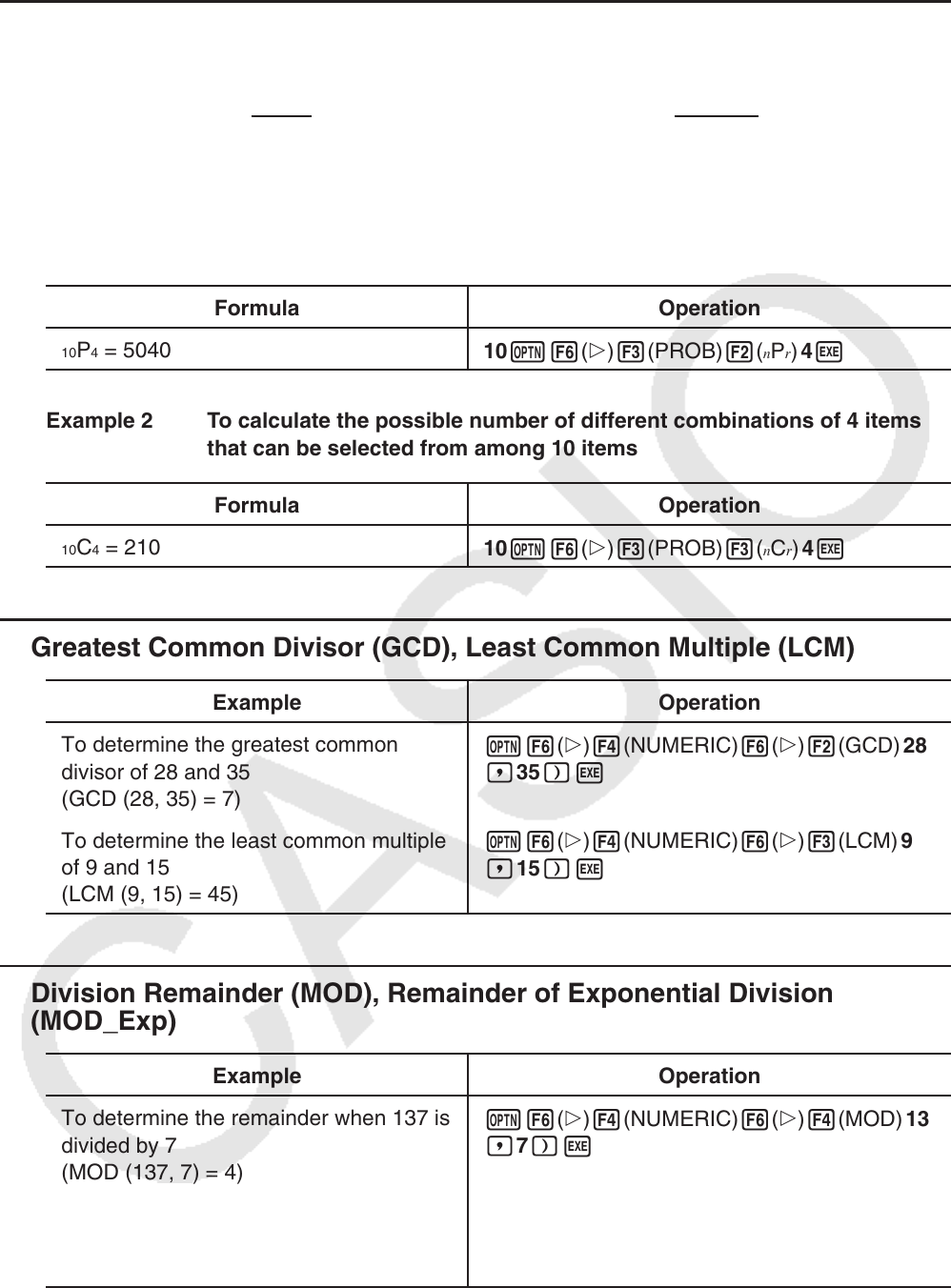User Manual
Table Of Contents
- Contents
- Getting Acquainted — Read This First!
- Chapter 1 Basic Operation
- Chapter 2 Manual Calculations
- 1. Basic Calculations
- 2. Special Functions
- 3. Specifying the Angle Unit and Display Format
- 4. Function Calculations
- 5. Numerical Calculations
- 6. Complex Number Calculations
- 7. Binary, Octal, Decimal, and Hexadecimal Calculations with Integers
- 8. Matrix Calculations
- 9. Vector Calculations
- 10. Metric Conversion Calculations
- Chapter 3 List Function
- Chapter 4 Equation Calculations
- Chapter 5 Graphing
- 1. Sample Graphs
- 2. Controlling What Appears on a Graph Screen
- 3. Drawing a Graph
- 4. Saving and Recalling Graph Screen Contents
- 5. Drawing Two Graphs on the Same Screen
- 6. Manual Graphing
- 7. Using Tables
- 8. Modifying a Graph
- 9. Dynamic Graphing
- 10. Graphing a Recursion Formula
- 11. Graphing a Conic Section
- 12. Drawing Dots, Lines, and Text on the Graph Screen (Sketch)
- 13. Function Analysis
- Chapter 6 Statistical Graphs and Calculations
- 1. Before Performing Statistical Calculations
- 2. Calculating and Graphing Single-Variable Statistical Data
- 3. Calculating and Graphing Paired-Variable Statistical Data (Curve Fitting)
- 4. Performing Statistical Calculations
- 5. Tests
- 6. Confidence Interval
- 7. Distribution
- 8. Input and Output Terms of Tests, Confidence Interval, and Distribution
- 9. Statistic Formula
- Chapter 7 Financial Calculation
- Chapter 8 Programming
- Chapter 9 Spreadsheet
- Chapter 10 eActivity
- Chapter 11 Memory Manager
- Chapter 12 System Manager
- Chapter 13 Data Communication
- Chapter 14 Geometry
- Chapter 15 Picture Plot
- Chapter 16 3D Graph Function
- Appendix
- Examination Mode
- E-CON4 Application (English)
- 1. E-CON4 Mode Overview
- 2. Sampling Screen
- 3. Auto Sensor Detection (CLAB Only)
- 4. Selecting a Sensor
- 5. Configuring the Sampling Setup
- 6. Performing Auto Sensor Calibration and Zero Adjustment
- 7. Using a Custom Probe
- 8. Using Setup Memory
- 9. Starting a Sampling Operation
- 10. Using Sample Data Memory
- 11. Using the Graph Analysis Tools to Graph Data
- 12. Graph Analysis Tool Graph Screen Operations
- 13. Calling E-CON4 Functions from an eActivity

2-22
k Permutation and Combination
u Permutation u Combination
• Be sure to specify Comp for Mode in the Setup screen.
Example 1 To calculate the possible number of different arrangements using 4
items selected from among 10 items
Formula Operation
10P4 = 5040
10K6(g)3(PROB)2(
nPr) 4w
Example 2 To calculate the possible number of different combinations of 4 items
that can be selected from among 10 items
Formula Operation
10C4 = 210
10K6(g)3(PROB)3(
nCr) 4w
k Greatest Common Divisor (GCD), Least Common Multiple (LCM)
Example Operation
To determine the greatest common
divisor of 28 and 35
(GCD (28, 35) = 7)
K6(g)4(NUMERIC)6(g)2(GCD) 28
,35)w
To determine the least common multiple
of 9 and 15
(LCM (9, 15) = 45)
K6(g)4(NUMERIC)6(g)3(LCM) 9
,15)w
k Division Remainder (MOD), Remainder of Exponential Division
(MOD_Exp)
Example Operation
To determine the remainder when 137 is
divided by 7
(MOD (137, 7) = 4)
K6(g)4(NUMERIC)6(g)4(MOD) 137
,7)w
To determine the remainder when 5
3
is
divided by 3
(MOD_Exp (5, 3, 3) = 2)
K6(g)4(NUMERIC)6(g)
5(MOD_Exp)5,3,3)w
n
!
n
!
n
P
r
=
n
C
r
=
(
n
–
r
)!
r
!(
n
–
r
)!
n
!
n
!
n
P
r
=
n
C
r
=
(
n
–
r
)!
r
!(
n
–
r
)!










